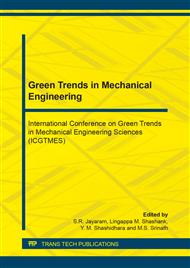p.115
p.122
p.127
p.134
p.139
p.144
p.152
p.158
p.164
Performance Analysis of Pongamia Biodiesel as an Alternative Fuel for CI Engine
Abstract:
India is a fastest growing major economy in 2018, with a growth rate of 7.4 per cent GDP. Energy use in developing countries like India has risen more than fourfold over the past three decades and is expected to continue increasing rapidly in the future. Energy is essential for a economical growth of any county. Biofuels derived from renewable resources will become a alternative supplement for the conventional energy sources in meeting the increasing requirements for transportation fuels. In the present paper, effort are made to evaluate the pongamia biodiesel of 20% Blend (PB20) with neat diesel as an alternative fuel for CI engine. The pongamia oil is converted into pongamia methyl esters (Biodiesel) using two step process Esterification and Transesterification. The fuel properties of raw pongamia methyl ester and blend (PB20) are evaluated as per ASTM/BIS standards to check their feasibility as an alternative fuel. The prepared blend is used to run the computerized CRDI diesel engine at different load conditions. From the experimental investigation made, PB20 has a potential to be as an alternative fuel for diesel engine. The performance of PB20 with respect to Brake Thermal Efficiency (BTHE), Mechanical Efficiency, Brake Mean Effective Pressure (BMEP) and Specific Fuel Consumption (SFC) is comparatively low when compared to neat diesel. The P-Ɵ and P-V diagram shows that the combustion of PB20 is as similar to that of neat diesel.
Info:
Periodical:
Pages:
139-143
Citation:
Online since:
November 2019
Authors:
Keywords:
Price:
Сopyright:
© 2019 Trans Tech Publications Ltd. All Rights Reserved
Share:
Citation:



